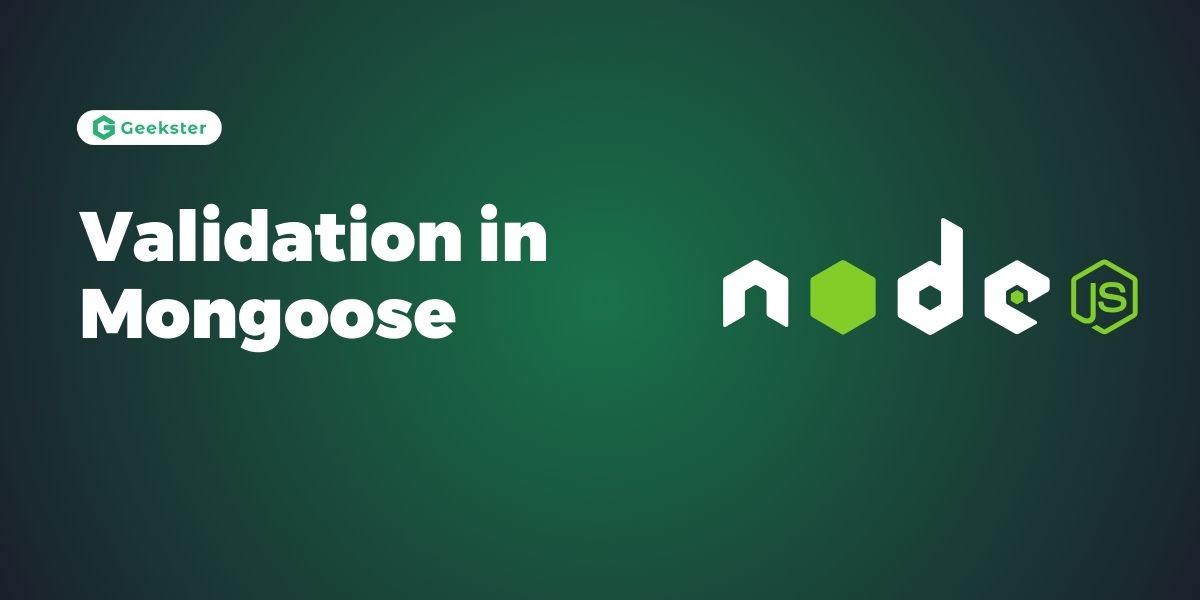Introduction
Validation in Mongoose is a critical feature that ensures the integrity and accuracy of the data stored in a MongoDB database. By using validation, developers can enforce rules and constraints on their schemas, preventing invalid data from being saved. This functionality is essential for maintaining data consistency, improving application reliability, and simplifying error handling.
With Validation in Mongoose, you can define various validators, such as required fields, value ranges, string lengths, and custom validation logic. These validators help to catch errors early in the data handling process, making it easier to debug and maintain your application. By incorporating robust validation mechanisms, Mongoose enables developers to create more stable and predictable applications
Types of Validation in Mongoose
Validation in Mongoose can be categorized into two main types: built-in validators and custom validators.
- Built-in Validators: Mongoose offers a set of built-in validators for common data types such as strings, numbers, dates, and arrays. These validators check for properties like required fields, minimum and maximum values, and pattern matching using regular expressions. For example, a schema might require a user’s email to follow a specific format or a product’s price to be a positive number.
- Custom Validators: While built-in validators cover many standard use cases, custom validators provide the flexibility to define complex validation logic. This can be useful for application-specific rules, such as checking if a username is unique or if a date falls within a specific range. Custom validators are functions defined within the schema that perform these checks and return validation results.
Syntax for Defining Validation Rules
const mongoose = require('mongoose');
const Schema = mongoose.Schema;
// Define a schema with validation
const userSchema = new Schema({
username: {
type: String,
required: true,
minlength: 3,
maxlength: 50
},
email: {
type: String,
required: true,
unique: true,
match: /^\S+@\S+\.\S+$/
},
age: {
type: Number,
min: 18,
max: 100
},
role: {
type: String,
enum: ['user', 'admin', 'moderator']
}
});
// Create a model
const User = mongoose.model('User', userSchema);
In this example:
usernameis required and must be between 3 and 50 characters long.emailis required, unique, and must match a valid email format.agemust be between 18 and 100.rolemust be one of the specified enum values (user,admin,moderator).
Common Validation Techniques
- Built-in Validators: Mongoose provides a variety of built-in validators such as
required,min,max,enum,match, etc., which you can use to enforce specific rules on schema fields. - Custom Validators: You can define custom validation logic using functions that return a boolean or a promise. This allows you to perform complex validations based on your application’s requirements.
- Async Validators: Validators can be asynchronous using
async/awaitor returning a promise, enabling you to perform database queries or external API calls for validation purposes. - Error Handling: Handle validation errors using Mongoose’s error handling mechanisms, which allow you to customize error messages and respond appropriately to validation failures.
Best Practices of Validation Techniques
- Define Clear Rules: Clearly define validation rules based on your application’s data requirements and business logic.
- Use Schema Types: Leverage Mongoose schema types and built-in validators to simplify and standardize validation logic.
- Test Validation Logic: Test validation thoroughly during development to ensure it behaves as expected under various scenarios.
- Handle Errors Gracefully: Implement error handling to provide informative feedback to users and handle validation errors gracefully in your application.
Why Validation is Important
- Data Integrity: Ensures that the data stored in the database is accurate and reliable.
- Consistency: Helps maintain a consistent data format, making it easier to query and analyze the data.
- Error Prevention: Catches errors at the application level before they reach the database, reducing the risk of corrupt or invalid data.
Example
const mongoose = require('mongoose');
const userSchema = new mongoose.Schema({
username: {
type: String,
required: [true, 'Username is required'],
minlength: [3, 'Username must be at least 3 characters long']
// min length should be 3 otherwise it will throw an error
},
email: {
type: String,
required: [true, 'Email is required'],
match: [/.+\@.+\..+/, 'Please enter a valid email address']
},
age: {
type: Number,
min: [18, 'Age must be at least 18'],
max: [65, 'Age must be below 65']
}
});
const User = mongoose.model('User', userSchema);Output
In this example, the userSchema defines validation rules for username, email, and age fields, ensuring that they meet specific criteria before the document is saved.
Conclusion
Validation in Mongoose is a crucial feature that helps enforce data integrity and consistency within a MongoDB database. By leveraging both built-in and custom validators, developers can ensure that their applications handle data accurately and robustly. Whether you are developing a small project or a large-scale application, understanding and implementing validation in Mongoose is key to building reliable and error-free software.
Frequently Asked Questions
Yes, you can skip validation using { validateBeforeSave: false } option or by calling .validate() method with { skipValidators: true }.
Mongoose provides error handling mechanisms such as try...catch blocks around save operations or using .catch() on promises to handle validation errors.
Yes, you can modify validation rules dynamically using methods like .set() on schema paths to update validators or options.

